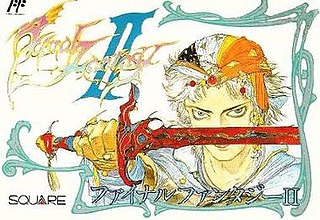
Final Fantasy II is a fantasy role-playing video game developed and published by Square in 1988 for the Family Computer as the second installment of the Final Fantasy series. The game has received numerous enhanced remakes for the WonderSwan Color, the PlayStation, the Game Boy Advance, the PlayStation Portable, iOS, Android and Windows. As neither this game nor Final Fantasy III were initially released outside Japan, Final Fantasy IV was originally released in North America as Final Fantasy II, so as not to confuse players. Following enhanced versions for iOS and Android in 2010 and 2012 respectively, the game was re-released again as part of the 2021 Final Fantasy Pixel Remaster series.
Front Mission is a collection of video games and related media produced by Square, now Square Enix. The series was created by Toshiro Tsuchida and developed by G-Craft, a studio that was later absorbed by Square and existed within Square Enix as Product Development Division-6. Since the release of the original Front Mission in 1995, the series has gone on to encompass several media, including film, manga, novels, radio dramas, mobile phone applications, and toys. While the series is primarily rooted in the turn-based tactical role-playing genre, it has also ventured into other genres such as side-scrolling shooter, real-time strategy (RTS), massive multiplayer online (MMO), and third-person shooter through its spin-offs. The Front Mission video games achieved moderate success, selling over 3 million units worldwide up until January 2006.

Dragon Quest VII: Fragments of the Forgotten Past is a 2000 Japanese role-playing video game developed by Heartbeat and ArtePiazza, and published by Enix for the PlayStation. It was released in North America in 2001 under the title Dragon Warrior VII. The game received a remake on the Nintendo 3DS in Japan in 2013, released in English under the title Dragon Quest VII: Fragments of the Forgotten Past in 2016. A version of the game for Android and iOS was released in Japan in 2015.

Front Mission 3, also known in Japan as Front Mission Third, is a tactical role-playing game for the PlayStation developed by and published by Square Co., Ltd., released in Japan in 1999, and North America and Europe in 2000. Front Mission 3 is the third main entry and the fifth entry overall in the Front Mission series. Like other Front Mission titles, Front Mission 3 is part of a serialized storyline that follows the stories of various characters and their struggles involving mecha known as wanzers.

Einhänder is a scrolling shooter developed by Square for the PlayStation console. It was released in Japan on November 20, 1997 and in North America on May 5, 1998. It was also re-released for the Japanese PlayStation Network on June 25, 2008. The name Einhänder is German and denotes a type of sword that is wielded with one hand, here used to refer to the single manipulator arm possessed by the player's spacecraft.

The Compilation of Final Fantasy VII is a metaseries produced by Square Enix. A subseries stemming from the main Final Fantasy franchise, it is a collection of video games, animated features and short stories set in the world and continuity of Final Fantasy VII (1997). Officially announced in 2003 with the reveal of Final Fantasy VII: Advent Children, the series' core products are three video games and one film release. Alongside these are tie-in products and spin-offs including books, mobile games, and an original video animation. Advent Children and the mobile title Before Crisis are a sequel and prequel to VII, respectively focusing on Cloud Strife, the original game's main protagonist, and covert operatives known as the Turks. Crisis Core follows Zack Fair, a minor character in VII, while Dirge of Cerberus, a sequel to Advent Children, follows Vincent Valentine, one of the original's optional characters. The series has since been expanded to include more products, most notably a planned trilogy of games remaking the 1997 original; the first installment in this trilogy, Final Fantasy VII Remake, was released in 2020, while the second installment, Final Fantasy VII Rebirth, was released the 29th of February 2024.
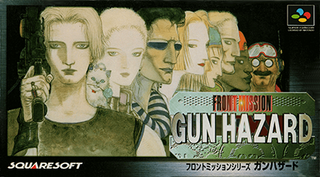
Front Mission Series: Gun Hazard is a 1996 side-scrolling shooter game developed by Omiya Soft and published by Squaresoft for the Super Famicom. It was released only in Japan on February 23. Gun Hazard is the second entry in the Front Mission series and is a side-scrolling shooter with role-playing game elements. The game received an English language fan translation in 2004.

Front Mission 4, also known in Japan as Front Mission Fourth, is a tactical role-playing game developed and published by Square Enix Co., Ltd. as the fourth main entry and sixth entry overall in the Front Mission series. Like other Front Mission titles, Front Mission 4 is part of a serialized storyline that follows the stories of various characters and their struggles involving mecha known as wanzers.

Front Mission Alternative is a real-time tactics video game developed and published by Square, and was released in Japan on December 18, 1997. Front Mission Alternative is the second spin-off entry and the fourth entry overall in the Front Mission series. Unlike other Front Mission titles, Front Mission Alternative is the precursor to the serialized storyline and features a completely standalone story and cast of characters.

Front Mission 5: Scars of the War, also known in Japan as Front Mission Fifth: Scars of the War, is a tactical role-playing game developed and published by Square Enix, released in Japan on December 29, 2005. Front Mission 5: Scars of the War is the fifth main entry and ninth entry overall in the Front Mission series. Like other Front Mission titles, Front Mission 5: Scars of the War is part of a serialized storyline that follows the stories of various characters and their struggles involving mecha known as wanzers.

Front Mission is a tactical role-playing game developed by G-Craft and published by Square, and was released in Japan on February 24, 1995 for the Super Famicom. Front Mission is the first main entry and the first entry overall in the Front Mission series. Front Mission is part of a serialized storyline that follows the stories of various characters and their struggles involving mecha known as wanzers. A direct port of the game was released for the WonderSwan Color in Japan on July 12, 2002.
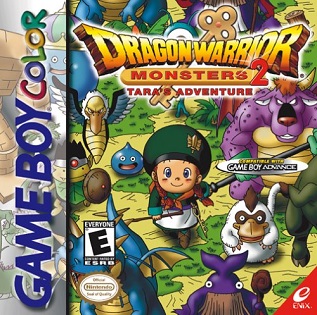
Dragon Warrior Monsters 2, known in Japan as Dragon Quest Monsters 2, is a role-playing video game published by Enix for the Game Boy Color. It is the second Dragon Warrior Monsters game for the Game Boy Color and features two different versions of the same game, Cobi's Journey and Tara's Adventure. Both games were remade in 2002 for the PlayStation in a compilation game called Dragon Quest Monsters 1+2 and released only in Japan. The Nintendo 3DS version combined both games into one and was released only in Japan in 2014 with the title Dragon Quest Monsters 2: Iru and Luca's Marvelous Mysterious Key. The 3DS version was later brought to iOS, Android on August 6, 2020, in Japan.

The Last Remnant is a role-playing video game developed and published by Square Enix. It was released worldwide for Xbox 360 in November 2008 and for Microsoft Windows in March 2009. A PlayStation 3 version was originally announced as well, but this version was cancelled. A remastered version titled The Last Remnant Remastered was released on PlayStation 4 in December 2018 and for Nintendo Switch in June 2019. The game follows a teenage warrior on a quest to end the war, in a fictional world divided into multiple city-states and inhabited by four different species. Their past includes a conflict over "Remnants", magical artifacts of varying forms. The game features a unique battle system in which the player commands multiple groups, or "unions", of characters rather than individual units.

Front Mission Evolved is a third-person shooter video game developed by Double Helix Games and published by Square Enix. Unlike previous Front Mission titles which have a tactical role-playing game structure, players engage in combat in real time on 3D maps using giant robotic weapons of war known as "Wanzers." The game also features a single player story mode and several multiplayer combat modes with up to eight players.

Front Mission 2089 is a tactical role-playing game developed by Square Enix Co., Ltd., MSF, and Winds, and was published and released in Japan by Square Enix Co., Ltd. in 2005 and 2008 for mobile phones. The game was released on March 7, 2005, October 27, 2005, and June 18, 2008. Front Mission 2089 is part of Front Mission Mobile, a project dedicated to Front Mission video games for the mobile phones. Front Mission 2089 is the fifth main entry and the seventh entry overall in the Front Mission series. Like other Front Mission titles, Front Mission 2089 is part of a serialized storyline that follows the stories of various characters and their struggles involving mecha known as wanzers. An enhanced remake of the game developed by h.a.n.d. was released for the Nintendo DS on May 29, 2008, titled Front Mission 2089: Border of Madness. A sequel, Front Mission 2089-II, was released for mobile phones in Japan in 2006 and 2008 for i-mode and EZweb services, respectively, continuing the story following a new main character.
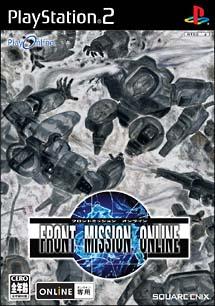
Front Mission: Online was a massively multiplayer online (MMO), third-person shooter video game developed by and published by Square Enix, and was released in Japan on May 12, 2005 for the PlayStation 2, and on December 8, 2005 for Windows. Like other Front Mission titles, Front Mission: Online is part of a serialized storyline that follows the stories of various characters and their struggles involving mecha known as wanzers. The game's servers were closed on May 31, 2008.
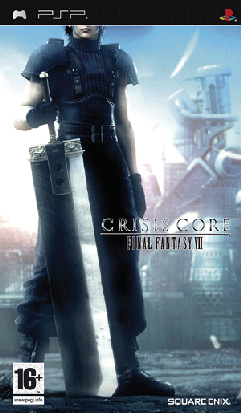
Crisis Core: Final Fantasy VII is an action role-playing game developed and published by Square Enix for the PlayStation Portable. The game was first released in 2007, and serves as a prequel to the 1997 video game Final Fantasy VII. It is part of the metaseries Compilation of Final Fantasy VII, which includes other products related to the original game.

Left Alive is a 2019 action-adventure stealth game developed by Ilinx and published by Square Enix. It was released in February and March 2019 for the PlayStation 4 and Windows platforms. It was announced at a press conference by Sony Interactive Entertainment before the 2017 Tokyo Game Show. Set in the universe of the Front Mission series of videogames, the story follows several individuals trying to survive amidst a surprise invasion of their country, while both helping civilians to safety and attempting to stop destruction and damage wrought by Wanzers, a form of combat mecha.

Final Fantasy III is a Nintendo DS role-playing video game and a remake of the 1990 Family Computer game, Final Fantasy III.

















